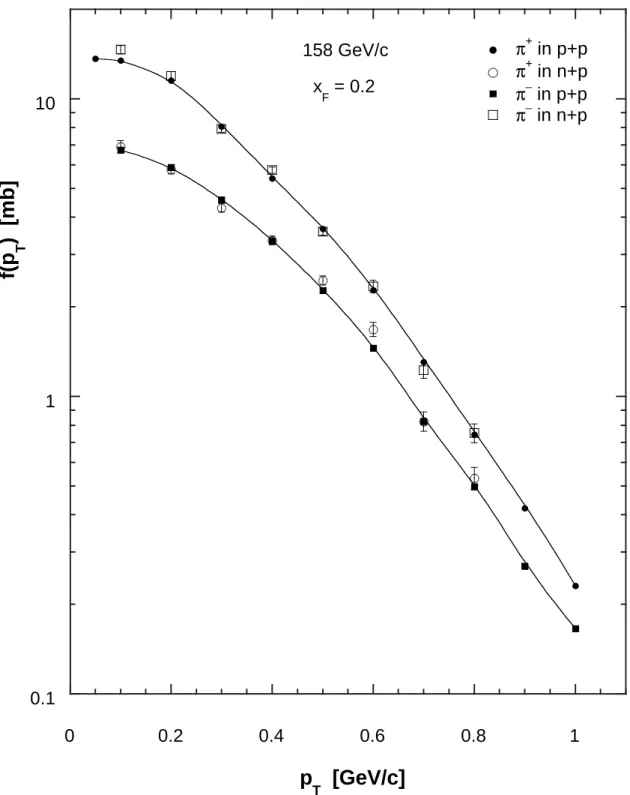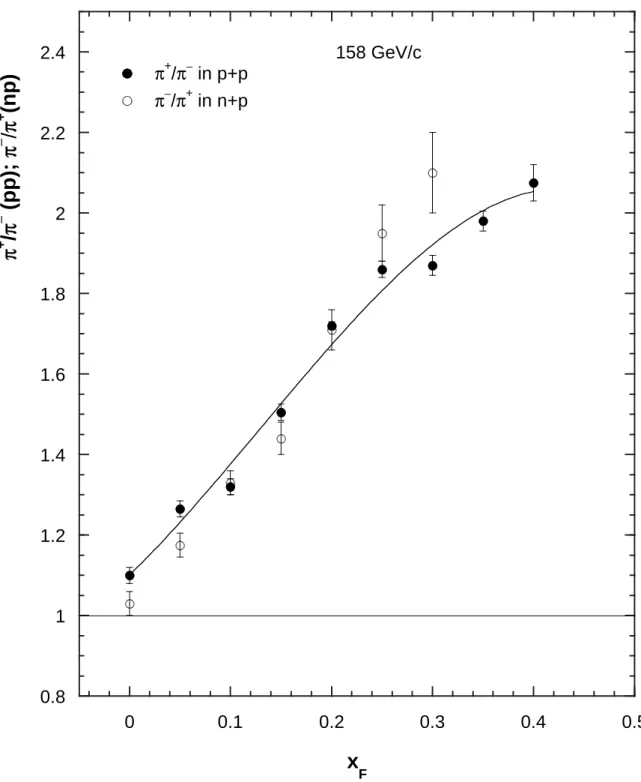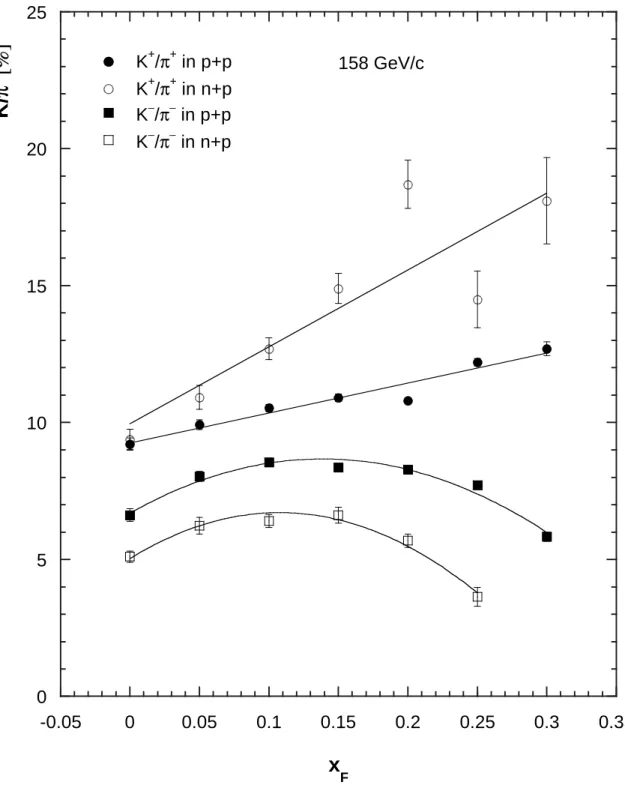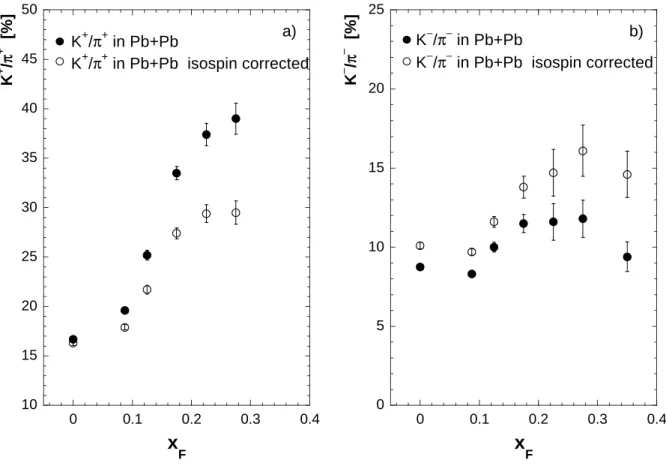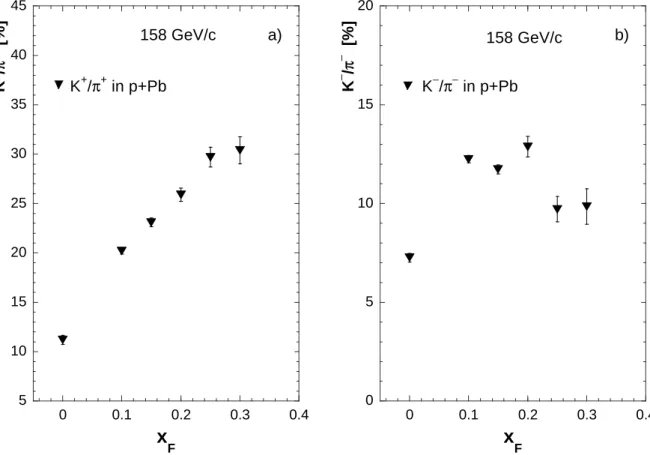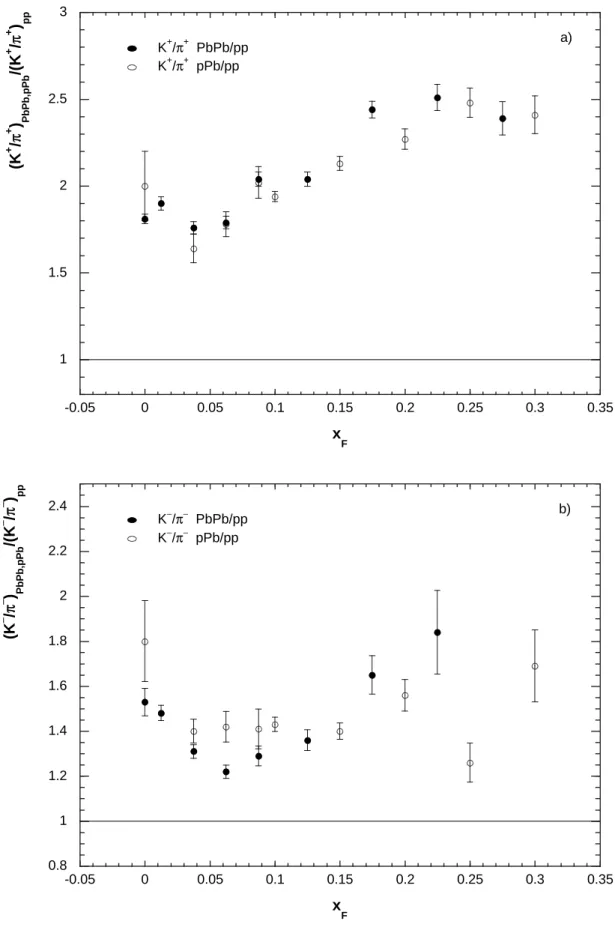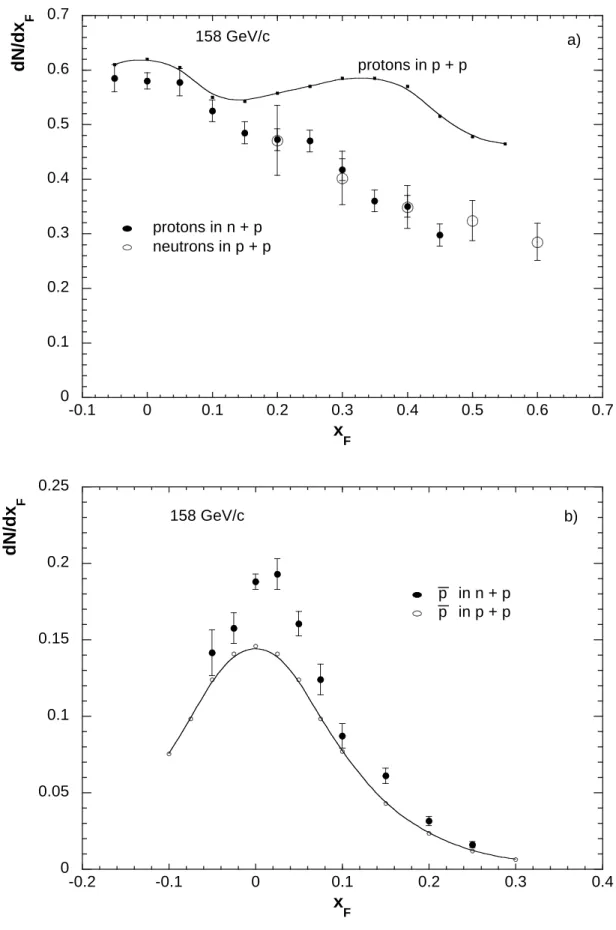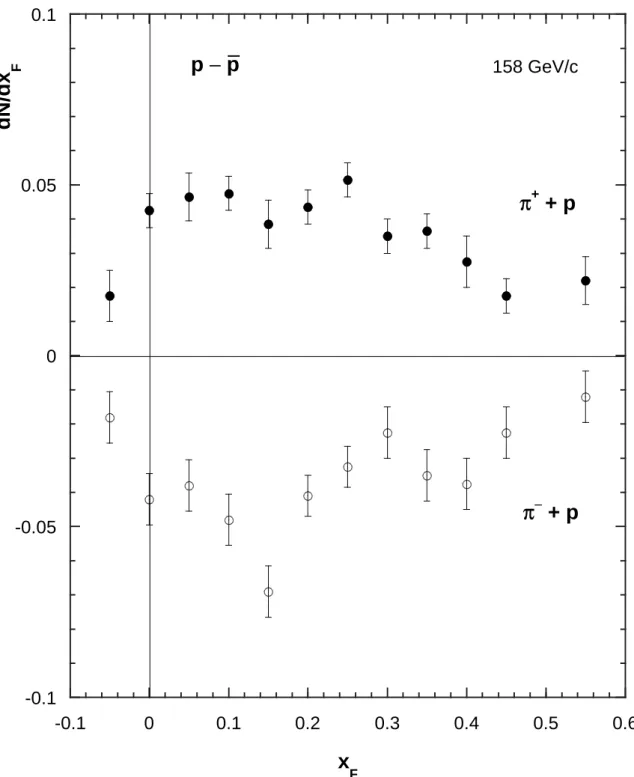EUROPEAN ORGANIZATION FOR NUCLEAR RESEARCH
CERN/SPSC 2002-008 CERN/SPSC/P264 Add. 10 4 March 2002
ADDENDUM–10 to PROPOSAL CERN/SPSC/P264
Progress Report and Beam Request for 2002
The NA49 Collaboration
Abstract
This document discusses the status of the analysis and physics results obtained by the NA49
experiment. For 2002 the collaboration maintains the request for 4 weeks of running with
proton beams. Furthermore the collaboration requests 10 days of Pb beam at 20 and 30
A · GeV and the full period of Pb-beam at 158 A · GeV energy. Most of the Pb-beam period
at full energy will be used for data taking with fragmentation deuterons.
S.V. Afanasiev
9, T. Anticic
19, D. Barna
5, J. Bartke
7, R.A. Barton
3, L. Betev
10, H. Białkowska
17, A. Billmeier
10, C. Blume
8, C.O. Blyth
3, B. Boimska
17, M. Botje
1, J. Bracinik
4, R. Bramm
10, R. Brun
11, P. Bunˇci´c
10,11, V. Cerny
4, O. Chvala
15, J.G. Cramer
16,
P. Csat´o
5, P. Dinkelaker
10, V. Eckardt
14, P. Filip
14, H.G. Fischer
11, Z. Fodor
5, P. Foka
8, P. Freund
14, V. Friese
13, J. G´al
5, M. Ga´zdzicki
10, G. Georgopoulos
2, E. Gładysz
7, S. Hegyi
5,
C. H¨ohne
13, P.G. Jones
3, K. Kadija
11,19, A. Karev
14, V.I. Kolesnikov
9, T. Kollegger
10, M. Kowalski
7, I. Kraus
8, M. Kreps
4, M. van Leeuwen
1, P. L´evai
5, A.I. Malakhov
9, C. Markert
8, B.W. Mayes
12, G.L. Melkumov
9, A. Mischke
8, J. Moln´ar
5, J.M. Nelson
3, G. P´alla
5, A.D. Panagiotou
2, K. Perl
18, A. Petridis
2, M. Pikna
4, L. Pinsky
12, F. P¨uhlhofer
13, J.G. Reid
16, R. Renfordt
10, W. Retyk
18, C. Roland
6, G. Roland
6, A. Rybicki
7, A. Sandoval
8, H. Sann
8, N. Schmitz
14, P. Seyboth
14, F. Sikl´er
5, B. Sitar
4, E. Skrzypczak
18, G.T.A. Squier
3, R. Stock
10, H. Str¨obele
10, T. Susa
19, I. Szentp´etery
5, J. Sziklai
5, T.A. Trainor
16, D. Varga
5,
M. Vassiliou
2, G.I. Veres
5, G. Vesztergombi
5, D. Vrani´c
8, S. Wenig
11, A. Wetzler
10, I.K. Yoo
13, J. Zaranek
10, J. Zim´anyi
51
NIKHEF, Amsterdam, Netherlands.
2
Department of Physics, University of Athens, Athens, Greece.
3
Birmingham University, Birmingham, England.
4
Comenius University, Bratislava, Slovakia.
5
KFKI Research Institute for Particle and Nuclear Physics, Budapest, Hungary.
6
MIT, Cambridge, USA.
7
Institute of Nuclear Physics, Cracow, Poland.
8
Gesellschaft f¨ur Schwerionenforschung (GSI), Darmstadt, Germany.
9
Joint Institute for Nuclear Research, Dubna, Russia.
10
Fachbereich Physik der Universit¨at, Frankfurt, Germany.
11
CERN, Geneva, Switzerland.
12
University of Houston, Houston, TX, USA.
13
Fachbereich Physik der Universit¨at, Marburg, Germany.
14
Max-Planck-Institut f¨ur Physik, Munich, Germany.
15
Institute of Particle and Nuclear Physics, Charles University, Prague, Czech Republic.
16
Nuclear Physics Laboratory, University of Washington, Seattle, WA, USA.
17
Institute for Nuclear Studies, Warsaw, Poland.
18
Institute for Experimental Physics, University of Warsaw, Warsaw, Poland.
19
Rudjer Boskovic Institute, Zagreb, Croatia.
1 Introduction
This report provides a summary of the status and future programme of the NA49 exper- iment at the CERN SPS. The history of the experiment is documented in a series of previous reports to the SPS Committee [1, 2, 3, 4, 5].
The primary purpose of the heavy ion programme at the CERN SPS is the search for evidence of a transient deconfined state of strongly interacting matter during the early stage of nucleus–nucleus collisions. The NA49 experiment [6] was designed for the investigation of hadron production in the most violent Pb+Pb interactions at the Cern SPS. With its large acceptance tracking and particle identification it is in addition an excellent detector for the study of nucleon–nucleus collisions of controlled centrality and of nucleon–nucleon reactions.
Data have been recorded on Pb+Pb collisions at 158, 80, and 40 A · GeV beam energy as well as smaller runs of C+C and Si+Si at 158 and 40 A · GeV. Moreover, extensive data sets were taken for hadron–nucleon (p+p, d+p, π +p) and hadron–nucleus (p+Pb, π +Pb) reactions. All raw data have been processed to the data summary tape status and are now in the process of physics analysis.
The status of physics analysis concerning elementary hadronic interactions is discussed in Section 2 with special emphasis on isospin effects and their consequences on the interpretation of heavy ion data. This concerns in particular the production of strange mesons as well as baryons and anti-baryons up to strangeness ±3 .
The NA49 programme concerning nucleus–nucleus collisions recently focused on the study of energy dependence of hadron production in central Pb+Pb collisions. The aim of this investigation is the search for anomalies in the energy dependence of experimental observables which may indicate the onset of deconfinement at low SPS energies. This status report presents selected results from the Pb runs at 40, 80 and 158 A · GeV in Section 3.1. These underline the importance of the completion of the energy scan programme this year with the approved low energy runs at 20 and 30 A · GeV.
High statistics data on central Pb+Pb collisions taken in 2000 are being analysed in a
search for rare signals: open charm production, φ decay in the di-electron channel, Ω and anti-
deuteron production. First preliminary results on these rare signals are presented in Section 3.2.
2 Results of Analysis of Hadron–Proton and Hadron–Nucleus Interactions
In the absence of a quantitative theory of soft hadronic interactions the interpretation of experimental results obtained in nucleus-nucleus collisions has to rely on a comparison with elementary hadron-hadron and hadron-nucleus reactions. As the heavy nuclei used in these studies have 60% neutron content, this comparison necessitates knowledge of hadronisation processes involving neutrons.
The behaviour of particle yields with respect to a rotation of the projectile isospin has not been studied experimentally in any quantitative detail. This behaviour will - in addition to the general concept of isospin symmetry - finally be governed by the hadronic production mechanisms involved. As will be shown below, the study of hadronic interactions with different projectile isospin will therefore offer more direct insight into the hadronization mechanism. The NA49 experiment has obtained in the years 1999/2000 pilot data with deuteron beam in order to provide data with neutron interactions. The inverse-kinematics deuteron+p configuration allows - by means of proton spectator tagging - the isolation of clean n+p collisions. We present here first results concerning final state pions, kaons, protons and anti-protons which allow scrutiny of the effects of projectile isospin rotation on particle yields, baryon and anti-baryon production and enhancement effects in kaon and cascade baryon production.
2.1 Experimental Procedure
The incoming Pb beam is fragmented into secondary nuclei in a 10 mm carbon target.
Z/A=1/2 nuclei are selected by appropriate setting of the beam line. Out of a mass spectrum which is rapidly falling with A, deuterons are selected by pulse height window cuts on the analog signals from beam scintillation and proportional counters. The deuterons impinging on a liquid H2 target produce n+p (proton spectator), p+p (neutron spectator) and about 17% (n+p)+p interactions (no spectator). The n+p collisions can be cleanly isolated by selecting spectator protons imposing tight cuts on their transverse and longitudinal momenta. A selection of 120 k n+p events has thus been obtained. This event number is about a factor of 20 below the statistics available in p+p interactions.
2.2 Results on Charged Pions
Projectiles n p
Produced particles π
−π
0π
+Isospin -1 0 +1
The expected (”trivial”) isospin symmetry in pion production i.e. the complete flip be- tween π
+and π
−yields when changing from proton to neutron projectile has not been mea- sured to any precision in the SPS energy range. Results as a function of transverse momentum at fixed x
Fare presented in Fig. 1 which shows that indeed charge reflection symmetry is achieved within statistical errors of a few percent over a wide range of p
T. This is extended to a wider x
Finterval in Fig. 2 which shows p
T-integrated π
+/π
−resp. π
−/π
+ratios as a function of x
F. Here two regions are of interest:
a) At low x
Fπ
−/π
+should approach 1 in n+p interactions if charge reflection holds. This
is borne out by the measurements shown in Fig. 2. The extent of the transition region in
x
Foffers a first determination of pion feed-over from target to projectile hemisphere. It is
visible that the feed-over is small already at x
F= 0.05 and vanishes at about x
F= 0.1 . This result is important for some of the conclusions drawn below.
b) At large x
Fthe pionic charge ratios become large and therefore allow a more sensitive test of charge reflection symmetry which is not a priori implied by isospin invariance. The present data (see Fig. 2) cannot exclude such effects and it would be desirable to obtain similar statistical errors in n+p and p+p reactions.
2.3 Results on Charged Kaons
Due to strangeness conservation the situation is more complex for strange meson produc- tion. In fact kaons may be produced
a) in conjunction with hyperons (”associate production”) and b) in pairs.
Mechanism (a) can be described by the following isospin quadruplet:
Strangeness
Projectiles n p
Produced particles K
0K
+1
K
−K
0-1
Isospin -1/2 +1/2
As in this process the s-quark is fixed in the hyperon, the K
+yield (s-quark) will not commute with the K
−yield (s-quark). K
−can only be produced here in the decay of Y
∗( Σ
∗) resonances which also yield K
0. Consequently, in the ”associate” hyperon-kaon channel, by exchanging p with n projectile, instead of K
+↔ K
−the commutation K
0↔ K
+and K
0↔ K
−should be dominant. This argument also raises questions about the isospin dependence of K
0sproduction which ”bridges” the multiplet by having both K
0and K
0content.
The kaon pair production mechanism (b) corresponds to the following isospin triplet:
Strangeness
Projectiles n p
Produced particles K
−K
0K
+K
−K
+K
00 K
0K
0Isospin -1 1
In this case – and in analogy with the pion triplet discussed in the preceding section – one has to expect a definite dependence of charged kaon production on projectile charge: K
+production should be reduced, K
−production enhanced when switching from p to n projectile.
The relative weight of mechanisms (a) and (b) in charged kaon production is not predicted from soft QCD. It can be expected, though, that process (a) should dominate in the threshold region at low cms energy, whereas process (b) should become more and more important as energy increases.
NA49 has obtained the first comparative measurement of charged kaons with both p and n beams. Fig. 3 shows kaon yields as a function of p
Tat two values of x
Fin the projectile region.
It is apparent that compared to the charged pions the charged kaons do not commute with
projectile isospin. Within statistical errors on the contrary, both K
+and K
−yield are invariant
against projectile charge. This observation carries strong consequences for K/ π ratios as shown
in Fig. 4 for K
+/ π
+and K
−/ π
−from protons and neutrons as a function of x
F. Interpretation of K/ π ratios from nuclei and their comparison to p+p interactions has therefore to take account of the proper isospin mixture in these nuclei. The necessary correction factors for Pb+Pb collisions are shown in Fig. 5: they reach (at 158 AGeV) values of up to 30%, depending on x
F. This is exemplified in Fig. 6 where K
+/ π
+and K
−/ π
−ratios from Pb+Pb collisions as measured by NA49 are presented both uncorrected and corrected for isospin effects.
NA49 has also obtained K/ π ratios from p+Pb interactions with controlled centrality.
Here the comparison to the elementary p+p collisions is straight-forward in the p projectile hemisphere, but suffers from isospin effects in the backward (Pb) hemisphere. In the transition region around x
F= 0 , in addition target-pile-up in this multiple collision process has to be taken into account. The measured K/ π ratios are shown in Fig. 7 as a function of x
F. Target feedover effects are expected to reach out to about x
F= 0.05 (see above) and can be corrected for by using the approximate linearity of target yields with the number of collisions (see arguments discussed below in Chapter 7.2 with respect to proton and cascade yields).
The thus corrected K/ π ratios are compared to Pb+Pb interactions in Fig. 8. Apparently, both for K
+and K
−ratios there is - within statistical erors - no difference visible between both types of reactions, and this over the complete x
Frange accessible to NA49. This constitues an important result for the interpretation of A+A collisions.
It would be of obvious interest to further reduce the statistical and systematic errors re- lated to these particle ratios. NA49 has already doubled the event numbers in p+Pb interactions in 2001. Further running with n+p and p+p collisions is now mandatory.
2.4 Results on Protons and Anti-protons
In baryon production a clear distinction between ”net” protons and neutrons which con- tribute to the overall baryon number balance and ”pair produced” baryons has to be made. The latter should always be treated together with their partners as baryon number free systems.
2.4.1 Net Protons and Neutrons
Net baryons can be arranged in the following isospin doublets:
Projectiles n p
Produced particles n p Isospin -1/2 +1/2
Although an isospin-symmetric behaviour of neutrons and protons with respect to pro- jectile charge seems obvious, the distribution of their cross sections over phase space is non- calculable and has therefore to be measured. In this respect the absence of reliable data on neutron production in p+p and proton and neutron production in n+p interactions is absolutely flagrant: hence a large uncertainty in properly predicting isospin-corrected baryon distributions for comparison with A+A data.
NA49 has performed a measurement of neutron production in p+p collisions and has
obtained for the first time proton and anti-proton yields from n+p interactions. The results are
given in Fig. 9. Discussing first the baryon cross sections it is seen (Fig. 9a) that indeed, as
expected, the neutron yields from proton projectiles are equal to the proton yields from neutron
projectiles. It should be stressed however that the shape of the measured x
Fdistributions is non-
trivial and directly connected to production mechanisms. The fact that proton yields at x
F= 0
are closely similar in n+p and p+p collisions has to do with the mechanism of baryon number transfer (stopping) which carries direct relevance also for p+Pb and Pb+Pb reactions.
2.4.2 Pair Produced Baryons
The first ever measurement of anti-proton production in n+p interactions presented in Fig. 9b shows a sizeable increase of anti-proton yield from n projectiles. When taking account of the fact that in n+p events there is at x
F' 0 a superposition from target protons and projec- tile neutrons (see arguments on π
+/π
−ratios above) the increase amounts to about 50%. This measurement has therefore immediate and rather profound consequences for the understanding of baryon pair production. Would pairs only be produced in the symmetric configurations pp and nn (isospin of the effective pair equal zero) this would mean a strong dependence of I=0 amplitudes on projectile isospin: there is no basis for this assumption. If however one allows for the presence of asymmetric pair configurations of the type pn or np then bb pairs can be arranged in the following multiplet which resembles the isospin 1 triplet of pions:
Projectiles n p
Produced particles pn pp pn nn
Isospin -1 0 +1
Under this assumption and taking into account the observed charge reflection symmetry for pions the measured effect is easily understood as flip from the pn configuration into the pn configuration when interchanging p and n projectile. There is however a pecularity in the above multiplet: unlike π
+and π
−protons and anti-protons turn also up in the I=0 symmetric configuration: the effect of any isospin reflection is therefore damped by this symmetric term. In this aspect the 50% excess of p in n+p corresponds to a very strong isospin correlation especially if compared to the 20% effect observed for π
+/π
−at x
F= 0 . This and the fact that the effective mass of the baryon pairs is above 2 GeV indicates that the study of pair produced baryons gives access to more primordial phases of hadronization processes. Supporting evidence for this picture comes from Lear experiments which were able to isolate in the inverse process pp
→ mesons final state high mass/high spin mesonic resonances.
NA49 would definitely benefit from enhanced statistics in both p+p and especially n+p interactions in pursuing this cycle of studies.
2.4.3 Baryon Pair Production with Pion Beams
The above results have been augmented by measurements of baryon and anti-baryon production with pion beams:
Projectiles π
−π
+Produced particles pn pp pn
nn
Isospin -1 0 +1
In experiments with pion beams one may use the fact that there should be no ”net” baryon
number produced in the hadronization of the projectile in order to isolate the contributions from
the target proton. This is done by defining an ”average pion” projectile 0.5· ( π
+beam + π
−beam). By subtracting the thus averaged baryon yields from the pion beam results the p target contribution is eliminated and one is left with baryon pair production from the pion projectile. In addition by using the difference p–p one may eliminate the I=0 symmetric pair component. The result presented in Fig. 10 shows again several important features of baryon pair production:
a) There is a strong component of asymmetric pn and np configurations.
b) This component commutates with projectile isospin.
c) The production mechanism of pp pairs becomes directly visible: the baryon/anti-baryon yields are not peaked at x
F= 0 but show a broad structure centered at x
F' 0.2 for pion beams, indicating a non-central production of the corresponding heavy mesonic parent states reaching out to high x
Fvalues.
2.5 Results Expected for Strange/Antistrange Baryon Production
In the following argumentation the above findings will be extended to the expected isospin dependence of strange and multistrange baryons. This should become experimentally accessible with better event statistics from n+p and p+p interactions.
Starting with the isospin multiplet structure for hyperon pair states (making no difference in notation between Λ
0and Σ
0which are anyway indistinguishable in most experiments)
Strangeness
Projectiles n p
Produced particles ΛΣ
−ΛΛ ΛΣ
+-1+1
Σ
−Λ Σ
+Λ
Isospin -1 0 +1
it becomes apparent that - due to the possible combination of isospin singlet states ( Λ , Λ ) with the isospin triplet of Σ states the isospin rotation of n and p projectiles should always yield the same number of pair produced neutral hyperons. Therefore, unlike in the case of anti-protons, anti-lambdas measure the complete yield of pair produced hyperons and, as a consequence, the difference Λ − Λ gives the correct number of ”net” hyperons independent of projectile type, again in sharp contrast to the difference p–p.
Verification of this prediction needs more n+p events.
Proceeding now to cascade hyperons, the following table applies:
Strangeness
Projectiles n p
Produced particles Ξ
0Ξ
−Ξ
0Ξ
0Ξ
0Ξ
+-2+2 Ξ
−Ξ
+Isospin -1 0 +1
This shows complete charge-antisymmetry with respect to the iso-doublet formed by
proton/anti-proton. Therefore, comparing e.g. Pb+Pb to p+p collisions, Ξ
+should be sup-
pressed, Ξ
−enhanced by simple isospin composition. This will be quantified in the following
chapter.
Strangeness
Projectiles n p
Produced particles Ω
−Ω
+-3+3
Isospin -1 0 +1
Ω
−and Ω
+form finally isospin singlets (see table on top) and should therefore, like Λ / Λ , not be affected by projectile isospin.
The possibility of strangeness-asymmetric pair combinations can however not be ex- cluded here. As the yield ratios between p/ Λ/Ξ/Ω production are about 1/10
−1/2 · 10
−3/10
−4such terms should in fact become more and more probable with decreasing cross section. Com- binations like e.g. Ω
−/Ξ
+or Ξ
−/Σ
+(plus evidently additional kaons) have to be taken into account.
The measurement of baryon production up to strangeness ±3 in elementary production is therefore a pre-requisite for the interpretation of nuclear baryonic data. The NA49 experiment has produced, in addition to data on p,p and Λ , Λ a first ever measurement of Ξ
−and Ξ
+yields in p+p interactions at 158 GeV/c.
Ω
−production just becomes accessible with the available number of events. From the current statistics approximately 45 Ω
−may be extracted as shown in Fig. 11. This represents a 3.5 σ significant signal over background measurement. Doubling the events statistics will allow to improve the measurement to 5 σ and to extract a reliable Ω
−cross-section.
Currently there is no signal visible for the Ω
+. However, with the presently measured Ω
−signal, we can test the level of exclusion of the Ω
+/Ω
−ratio. With a 95% confidence level, this ratio is below 0.5. With two times higher statistics and assuming no Ω
+signal, we will be able to exclude at the same confidence level a ratio above 0.35.
The situation may be summarized in Fig. 12 where anti-baryon/baryon ratios are shown up to strangeness ±3 for p+p collisions. There seems to be an almost linear increase of the b/b ratios with strangeness content, leaving the possibility - by extrapolation to Ω/Ω - of a ratio of order 1 at S= ±3 . The upper limit obtained for Ω
+production excludes already such an extrapolation. The complex situation is further highlighted by the fact that practically all available microscopic production models predict very large Ω
+/Ω
−ratios in p+p collisions ranging up to factors of 2 and more [7].
2.6 Comparison of Cascade Baryon Production in p+p, p+Pb and Pb+Pb collisions In the following the problems of comparison between different hadronic processes, of isospin effects and of the interpretation of ”enhancement” effects will be exemplified for the case of cascade baryon production.
Measurements of cascade baryon cross sections are available from the WA97 [8] and
NA49 [9] experiments at the SPS and are given in Table 1. These measurements fortunately
enough cover a wide range of hadronic interactions with a welcome overlap which allows con-
trol of consistency. The table also contains two very important normalisation and reference
numbers: the number of ”wounded nucleons” NW and the number of collisions ν per projectile
nucleon characterizing each reaction.
pp pBe pPb pPb pPb PbPb PbPb
NA49 WA97 WA97 NA49 NA49 WA97 NA49
NW 2 2.5 4.7 4.7 6.7 350 362
ν 1 1.5 3.7 3.7 5.7 4.5 4.5
Ξ
−0.00074 0.0015 0.003 0.004 0.0058 1.5 1.49 Ξ
+0.00036 0.00068 0.0012 0.0014 0.0018 0.37 0.33
Table 1:
2.6.1 Comparison of Pb+Pb and p+p Interactions
Dividing the cascade yields in Pb+Pb collisions by the number of participant pairs (equal NW/2) one obtains, now seen per participant pair collision, and averaging over the NA49 and WA97 results (which agree within their 15% error limits) the following central rapidity densi- ties:
isospin corrected
Ξ Ξ Ξ Ξ
p+p 0.00074 0.00036 0.00096 0.00028 Pb+Pb 0.0082 0.0019
PbPb/pp 11.0 5.3 8.54 6.8
The above ratios constitute (a) a very sizeable cascade baryon enhancement and (b) a difference of a factor of two in enhancement between baryon and anti-baryon. The difference in isospin composition between p+p and Pb+Pb collisions should however, as discussed in chapter 6 above, be taken into account. It has been shown that one has - at least for Ξ pair production, to expect a decrease in Ξ and an increase in Ξ yield when switching from p to n projectile. Assum- ing this isospin effect to be of the same order as the one for protons/anti-protons quantified in Chapter 5 as about 1.5, the resulting net correction factor for the elementary nucleon+ nucleon collision would be (0.6 · 1.5 + 0.4 · 1.0) = 1.3 . The application of this correction changes the enhancement of Ξ
−and Ξ
+to 8.5 and 6.8 respectively. As a consequence, the difference in baryon and anti-baryon enhancements is drastically reduced.
It should be clear from this example that the measurement of Ξ and Ξ cross sections in both p+p and n+p collisions is absolutely necessary for argumentations about the excess of cascade production in A+A reactions.
2.6.2 Comparison of p+A and p+p Interactions
Contrary to the symmetric nucleon+nucleon and nucleus+nucleus interactions discussed
above, the hadron+nucleus collisions are by construction asymmetric. At a given impact pa-
rameter the projectile hadron will hit ν target nucleons (see table 1 above). The projectile frag-
mentation will thus be characterized by hadronization after multiple collisions, as is the case
for all participating nucleons in a nucleus+nucleus interaction. The ”wounded” target nucleons
in a p+A reaction on the contrary are only hit once and are therefore - in their fragmentation
- characterized by single collision physics i.e. close to the elementary nucleon+nucleon inter-
action. The final state hadron density will therefore have two components: a target component
which is the approximate sum of ν elementary hadronisation processes and a projectile compo- nent which carries the imprint of multiple ( ν ) collisions. Only the latter component should be comparable to nucleus+nucleus interactions.
The NA49 experiment has been able to check the superposition argument evoked above for the target component in the specific case of net baryon production in p+Pb collisions. Using data from both π
++Pb and π
−+Pb interactions which have no ”net” baryon content on the projectile level (see also argumentation concerning π
++p and π
−+p in chapter 5 above) one can use the quantity p–p in order to measure directly the evolution of target baryon density with the number nu of collisions. The result of this measurement is given in Fig. 13. Here the net proton density is plotted as a function of x
Ffor p+p collisions and average π +Pb collisions at two different impact parameters corresponding to 2.2 and 4.7 projectile collisions. The approximate linearity of yield against ν at x
F= 0 is evident.
This observation allows to set up a simple superposition formula for particle yields at xF=0 in p+A collisions:
(dn/dx)
px+FA=0= (dn/dx)
px+Fp=0· (0.5 · (ν · α) + 0.5 · E) ,
where the ”enhancement factor” E describes the deviation of the projectile component (multiple collisions) from the simple p+p behaviour (single collision) and the parameter α the influence of isospin effects on particle yield due to the composition of A from by protons and neutrons.
This formula demonstrates clearly that with increasing number of collisions the relative weight between target ”pile-up” and projectile fragmentation becomes bigger and bigger con- trary to A+A collisions where this formula should read:
(dn/dx)
AxF+=0A= (dn/dx)
NxF+=0N· (0.5 · E + 0.5 · E) · NW/2 .
The visibility of any enhancement effect due to multiple collisions is therefore strongly suppressed in p+A in comparison to A+A collisions for central x
F(see argumentation of Chap- ter 4 for kaon production).
By applying the above formalism the cascade baryon measurements of table 1 in p+A interactions can now be confronted with both the elementary p+p and the multi-collision Pb+Pb results and the enhancement factors E extracted from the data, see Fig. 14. From this figure two conclusions may be drawn:
a) With or without taking into account isospin effects the cascade yields measured in Pb+Pb collisions comply within experimental errors with the ν -dependence extrated from p+p and p+Pb interactions.
b) The application of isospin effects of the expected order of magnitude reduces the differ- ence between Ξ
+and Ξ
−enhancements both in p+Pb and Pb+Pb reactions.
Both findings agree with what has been concluded in Chapter 4 for K meson production.
It is clear that - in order to replace conjecture by reality as far as isospin effects are concerned - the measurement of Ξ
+and Ξ
−with neutron beam is a necessity. This is what NA49 proposes to do in 2002.
2.7 Improvement of Data Taking Efficiency by Triggering on Proton Spectators
The pilot run with deuteron beam in 1999 used the standard NA49 triggering scheme with
the addition of a pulse height cut as described above. Spectator selection was done off line once
the complete data sample was processed.
For future deuteron beam running the data taking efficiency may be improved by a factor of about 4 by introducing an on-line trigger on spectator protons. Due to their small p
Tval- ues ( ≤ 100 MeV/c) and their small spread in longitudinal momentum these are confined to a tiny area of only a few cm in diameter in the downstream part of the experiment. A scintilla- tion counter of the required size (together with a newly constructed proportional chamber with 100 µ m space resolution) will allow for fast triggering on proton spectators and a precision measurement of their momentum.
The expected number of events in the 23-day period of 160 AGeV Pb-beam foreseen in 2002 would thus allow to collect about 1.6 Mevents on DST. This event sample compares favourably with the 2.5 M events currently available from p+p interactions. It would contain more than 400 Ξ
−and more than 100 Ξ
+(already including the expected reduction of Ξ
+yield by isospin effects) which should allow a sensible determination of the baryon cross sections and of baryon/anti-baryon ratios up to cascades. In addition the arguments developed above concerning meson production could be quantified to a statistical accuracy comparable to p+p collisions.
2.8 Status of p+p and p+Pb Event Samples and Analysis
NA49 has proposed in October 2000 a programme of data taking with p+p and p+A interactions reaching over three years up to the end of 2003, requesting 4 weeks of proton beam per year. The SPSC has granted a period of 28 days in 2001. In preparation of this data taking the NA49 detector was upgraded by the construction of a new TPC which closes the acceptance hole at x
F≥ 0.5 imposed in the standard TPC setup by the presence of the Pb-beam in Pb+Pb running.
In accordance with the plans put forward, data taking was arranged as follows:
p+Pb at 160 GeV/c: 1 480 000 events → 1 000 000 events on DST p+Pb at 100 GeV/c: 850 000 events → 590 000 events on DST
These two items fulfill the plans for doubling up the available event number in p+Pb at different centralities and of studying energy dependence. It is evident that these new data constitute a large amelioration for the analysis presented above. In addition, further data with pion beams have been obtained:
π
−+Pb at 160 GeV/c: 790 000 events → 550 000 events on DST π
++Pb at 160 GeV/c: 420 000 events → 290 000 events on DST
Data processing of the π
−+Pb sample has already been performed and results have en- tered the physics results shown above.
In addition, NA49 was able to benefit of 13 days of p beam with the special LHC spill structure. These data have reduced duty cycle and are in principle not well adapted to detectors with long open time like the NA49 TPC system. Using the detailed beam timing information available in NA49 and special background rejection techniques it has been nevertheless possible to collect efficiently the following data:
p+p at 160 GeV/c: 1 100 000 events → 550 000 events on DST (special spill)
All these new data will be processed in the near future and will enter into the continuing data analysis which is being actively pursued. It should be evident from the above physics argumentation that a further sizeable increase in p+p statistics, as it has been requested in 2000, will be of great benefit for most of the physics subjects studied and is indeed our next priority.
This should help to obtain measured cross sections also for Ω
−and Ω
+to give only one example.
3 Selected Results from the Study of Nucleus–Nucleus Collisions 3.1 Energy Dependence
The results from the heavy-ion program at CERN indicated that deconfinement may set in within the SPS energy range [10],[11]. Within most model scenarios the data imply that the initial energy density exceeds the critical value. Originally proposed signatures [12] of the QGP were observed in Pb+Pb collisions at the top SPS energy, i.e. J/Ψ suppression, strangeness enhancement, and possibly thermal photons and dileptons. The significance of these signals as QGP signatures has come under renewed scrutiny. Moreover, there is no observational evi- dence for a sharp phase transition from QGP to hadrons such as phase coexistence [13], critical fluctuations [13, 14] or more speculative effects like DCC [15] or parity violation [16].
The NA49 experiment is performing an energy scan from 20–158 A · GeV in an effort to strengthen the evidence for the onset of deconfinement by searching for anomalies in the energy dependence of experimental observables. Data at 40, 80 and 158 A · GeV have so far been recorded and analysed and selected preliminary results are presented below.
3.1.1 Yields of π , K, Λ and Λ ¯
Raw K
+and K
−yields were extracted from fits of the distributions of dE/dx and TOF (where available) in narrow bins of rapidity y and transverse momentum p
T. The resulting spectra were then corrected for geometrical acceptance, losses due to in–flight decays and re- construction efficiency. The latter was determined from embedding simulated tracks into real events and amounted to ≈ 95%. Spectra of π
−mesons were derived from the acceptance cor- rected negatively charged particle yields in p
Tand y (assuming the π mass) by subtracting the estimated contribution of K
−, ¯ p and the contamination from secondary hadron decays. The ratio π
+/ π
−was determined in the region where both dE/dx and TOF are available (0.91, 0.94 and 0.97 at 40, 80 and 158 A · GeV) and was assumed to be y independent.
The resulting rapidity distributions of π
−are plotted in Fig. 15. The integrated yields are 312 ± 15, 445 ± 22 and 610 ± 30 at 40, 80 and 158 A · GeV respectively. Pions are the dominant produced particle species and thus their number provides a measure of the entropy in a statistical model description of the reaction. The yield of pions (estimated here as hπi = 1.5 · (hπ
−i + hπ
+i) ) divided by the number of wounded nucleons (participants) N
Wis shown versus the Fermi energy variable F ≡ ( √
s − 2m
N)
3/4/ √
s
N N1/4≈ s
1N N/4in Fig. 16. While p+p data show a linear rise throughout there is a change for A+A collisions (illustrated more clearly in the inset) in the SPS energy range. Below one finds a regime of slight suppression, above a region of enhancement with a steeper linear rise than for p+p reactions. This steepening must be due to collective effects and may be interpreted as indicating the activation of a large number of partonic degrees of freedom at the onset of deconfinement [17].
Kaons contain about 75% of the s, s ¯ quarks in the produced hadrons at SPS energies and
thus their number indicates the total strangeness content of the final state. The rapidity distri-
butions are displayed in Fig. 17 and integrate with small extrapolation to total yields of 18 ± 1,
29 ± 2, 50 ± 5 for K
−and 56 ± 3, 79 ± 5, 95 ± 9 for K
+at 40, 80, 160 A · GeV respectively. Yields of most particles, of course, increase with energy. Changes in the composition of the produced system are better characterised by particle ratios. Measurements of K
−/ π
−and K
+/ π
+at midra- pidity from NA49 are plotted versus energy in Fig. 18 and compared to results at lower and higher energies. A continuous increase is seen for K
−/ π
−. For K
+/ π
+one finds a steeper rise followed by a maximum at the lower end of the SPS energy region and a gradual decrease.
Within a reaction scenario based on nucleon–nucleon collisions these features might be at- tributed to thresholds and the decrease of the baryon density with increasing energy. The ratio K
−/ π
−exhibits the threshold of the K K production mechanism. The lower mass threshold of ¯ associate KY production leads to a steeper rise in K
+/ π
+and the rapidly falling baryon density may result in a compensation of the declining contribution from the KY by the growing contri- bution from the K K production mechanism. It will be interesting to see whether the excitation ¯ function of the K/ π ratio in nucleon–nucleon collisions supports such an interpretation.
The most abundantly produced hyperons are Λ and Λ ¯ for which Fig. 19 shows the rapidity distributions. These show a broad shape for Λ reflecting the associate production mechanism and the partially stopped participant nucleon distribution. In contrast the distribution is of nar- rower Gaussian type for Λ ¯ which are most likely produced as members of hyperon–anti-hyperon (Y Y) pairs. The ratios ¯ hΛi / hπi and h Λi ¯ / hπi of 4 π integrated yields are displayed as a function of energy in Fig. 20. One observes a steep threshold rise for the hΛi / hπi ratio followed by a decline which can be mainly attributed to the rapidly decreasing net baryon density. The ratio h Λi ¯ / hπi exhibits a continuous rise due to the high mass Y Y threshold. ¯
It is apparent from Fig. 19 that the hyperon rapidity coverage of NA49 which is com- plete at 40 A · GeV beam energy shrinks to about half the available phasespace for 158 A · GeV.
In order to improve on this situation it is proposed to take data with a modified detector con- figuration during part of the 2002 full energy Pb-beam run. A reduction of the magnetic field combined with a target position closer to the first TPC will extend the coverage in the backward hemisphere close to target rapidity ( −2.2 ≤ y
cms≤ −1.5 ). This will allow a determination of the Λ multiplicity in full phase space with only small extrapolation and systematic uncertainty also at the top SPS energy.
Since anti-hyperon production rates are small and isospin symmetry approximately holds ( h K
+i ≈ h K
0i ) nearly half of the s ¯ quarks in the produced hadrons are contained in K
+mesons.
Moreover, strangeness conservation requires hsi = h¯ si . Thus h K
+i measures to a good approxi- mation one quarter of all s and s ¯ quarks in the final state hadrons. The energy dependence of the h K
+i / hπ
+i ratio (see Fig. 21 left) therefore indicates a maximum in the fraction of strangeness carrying particles in the lower SPS energy range.
Microscopic dynamical and statistical models have been used extensively to describe par- ticle yields in a wide variety of reactions. The first class is often based on string excitation, fu- sion and hadronization (e.g. HSD [18], RQMD [19], UrQMD [20]) followed by re-interactions of the formed hadrons (RQMD, UrQMD). As seen from Fig. 18 HSD does not reproduce the en- ergy dependence of the midrapidity K
+/ π
+ratio. On the other hand, RQMD correctly predicts the trend, but somewhat over-predicts the ratio in the SPS energy range.
A comparison with the 4 π ratio h K
+i / hπ
+i is presented in Fig. 21 left. Both UrQMD and RQMD get the steep threshold rise. UrQMD values are much too low in the plateau due to an over-prediction of pions. RQMD does not follow the drop in the SPS range which is indicated by the measurements.
The statistical hadron gas model as such makes no prediction concerning the energy de-
pendence of particle production. However, it has recently been supplemented [21] by a param-
eterisation of the energy dependence of its two main parameters, baryo-chemical potential µ
Band temperature T. Predictions are shown in Fig. 21 left for h K
+i / hπ
+i and Fig. 20 right for hΛi / hπi . The trend of the data is well reproduced by this extended statistical hadron gas model calculation. In detail the decrease in the SPS energy range of both h K
+i / hπ
+i and hΛi / hπi and even more so of hΞi / hπi (not shown) is not well described.
Predictions have also been published for a statistical model of the early stage which explicitly assumes formation of a transient deconfined phase above a certain threshold en- ergy [17]. In this model the strangeness to entropy ratio is assumed to be established ini- tially and to persist through the hadronization stage. A measure of this quantity is the ratio E
s= (hΛi + hK + ¯ K i)/hπi evaluated from the final hadron multiplicities which is plotted in Fig. 21 right. After a rise corresponding to the purely hadronic reaction in the model, one observes a saturation at the a level consistent with the strangeness to entropy ratio expected for an initially deconfined system.
3.1.2 ππ correlations
Correlations of pions with near equal momenta p
1, p
2provide information on the size and internal dynamics of the fireball source at freeze–out [22]. The analysis was performed in the longitudinally comoving reference frame, decomposing the momentum difference Q = p
1- p
2into long, side, out components. For π
+π
−pairs the correlation peak at small Q is predominantly due to the Coulomb attraction and can be well reproduced by a Coulomb wave calculation [23]
using the measured effective source size. Correlations of π
−π
−are described by a product of parameterised Coulomb repulsion [23] and the quantum statistics enhancement, fitted with a Gaussian parameterisation. The resulting radius parameters R
side, R
out, R
longare plotted in Fig. 22 versus the average transverse momentum K
Tof the pair. No striking energy dependence is observed. Within expanding source models the decrease with K
Tis a manifestation of the strong longitudinal (R
long) and radial (R
side, R
out) collective flow at SPS energies. Moreover, there is little change in the lifetime τ
0≈ R
longq
